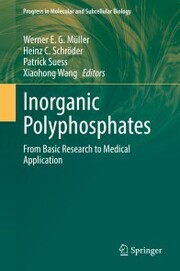Detailansicht
Inorganic Polyphosphates
eBook - From Basic Research to Medical Application, Progress in Molecular and Subcellular Biology
ISBN/EAN: 9783031012372
Umbreit-Nr.: 6114233
Sprache:
Englisch
Umfang: 0 S., 5.70 MB
Format in cm:
Einband:
Keine Angabe
Erschienen am 13.06.2022
Auflage: 1/2022
E-Book
Format: PDF
DRM: Digitales Wasserzeichen
- Zusatztext
- <p>This volume focuses on the biomedical aspects of inorganic polyphosphates, a family of unique bio-inorganic polymers.</p><p>In recent years, great advances have been made in understanding the development, metabolism, and physiological role of inorganic polyphosphates. These energy-rich polymers, which consist of long chains of phosphate units, are evolutionary old molecules. The acidocalcisomes, conserved organelles from bacteria to humans, as well as the mitochondria play a central role in polyphosphate production and storage. Polyphosphates have been assigned multiple functions, some of which are closely related to medically important processes, such as blood coagulation and fibrinolysis, energy metabolism, cell cycle regulation, apoptosis, chaperon function, microvascularization, stress response, neurodegeneration and aging. The development of bioinspired polyphosphate particles, in combination with suitable hydrogel-forming polymers enabled the development of new strategies in regenerative medicine, in particular for hard and soft tissue repair, but also in drug delivery and antimicrobial defense.&nbsp;</p><p>This book not only highlights the basic research in this area, but also discusses possible applications. Therefore, it appeals to scientists working in cell biology, biochemistry, and biomedicine and practicioners alike.</p><div><br></div><p></p>
- Kurztext
- This volume focuses on the biomedical aspects of inorganic polyphosphates, a family of unique bio-inorganic polymers.In recent years, great advances have been made in understanding the development, metabolism, and physiological role of inorganic polyphosphates. These energy-rich polymers, which consist of long chains of phosphate units, are evolutionary old molecules. The acidocalcisomes, conserved organelles from bacteria to humans, as well as the mitochondria play a central role in polyphosphate production and storage. Polyphosphates have been assigned multiple functions, some of which are closely related to medically important processes, such as blood coagulation and fibrinolysis, energy metabolism, cell cycle regulation, apoptosis, chaperon function, microvascularization, stress response, neurodegeneration and aging. The development of bioinspired polyphosphate particles, in combination with suitable hydrogel-forming polymers enabled the development of new strategies in regenerative medicine, in particular for hard and soft tissue repair, but also in drug delivery and antimicrobial defense. This book not only highlights the basic research in this area, but also discusses possible applications. Therefore, it appeals to scientists working in cell biology, biochemistry, and biomedicine and practicioners alike.
- Autorenportrait
- <div><br></div><div><b>Werner E.G. Mülle</b>r is a university professor at the Medical Center of the University Mainz and head of an ERC Advanced Investigator Grant Group. For his pioneering work in enzymology, molecular biomineralization, and molecular evolution, he has received nearly 20 national and international awards, including the Federal Cross of Merit, First Class of Germany. His current research focuses on applying this knowledge to the development of energy-delivering biopolymers/polyphosphates based (nano)biomaterials for regenerative medicine (bone and cartilage repair, wound healing, etc.). He has more than 1,200 publications (h-index: 88 [ISI-WOS]) and 20 granted patents. In addition to his ERC Advanced Investigator Grant, he has received three ERC-PoC Grants on repair/regeneration of bone, cartilage and blood vessels. He is/was also the coordinator of further European Grants as well as national DFG, BMWi and BMBF Grants.</div><div><b><br></b></div><div><b>Heinz C. Schröder</b> is a chemist and physician and gained his doctorate in both disciplines with distinction. 1982-1983 Liebig fellowship at the Max Planck Institute for Biophysical Chemistry in Göttingen, Germany, and 1988 fellowship at the National Cancer Center Research Institute, Tokyo, Japan. Since 1985 he has been a professor at the University Medical Center of Johannes Gutenberg University Mainz. His present research interests include the investigation of the physiological function of polyphosphates, as well as the formation of biogenic nanoparticles, and their biomedical application. H. C. Schröder has received several awards and is author or co-author of more than 500 scientific publications (h-index: 64 [ISI-WOS]). Together with Prof. Dr. W.E.G. Müller, he was involved as a coordinator or partner in more than 20 EU projects.</div><div><br></div><div><b>Patrick Suess</b> is a biochemist and cell biologist. In 2018 he was awarded the Texas A&M Roozbeh Arianpour Memorial Scholarship in Biology, and in 2020 was awarded a NIH/NHLBI-funded T32 training fellowship in molecular and translational hematology. Since 2018 he has been a postdoctoral fellow in the lab of Jim Morrissey at the University of Michigan, Ann Arbor. His current research focuses on the physiological roles of polyphosphates released from activated platelets. <br></div><div><p><b>Xiaohong Wang</b> is a chemist and material scientist. In 2005 she became a professor in inorganic chemistry. She has a long-standing expertise in the development and characterization of regenerative-active materials and the molecular processes underlying their biological/morphogenetic activity. Since 2006 she has been working together with W.E.G. Müllers group and she joined his group in 2009. Her scientific work (more than 200 peer-reviewed publications, Hirsch h-index: 41 [ISI-WOS]) was supported by several grants, as the coordinator or a PI, including four EU-funded projects (Core-Shell, SPECIAL, MarBioTec, and H2020 InnovaConcrete), and grants from the German Ministry of Research, like the ongoing SKIN-ENERGY project on wound healing. In addition, she is scientific coordinator of the German-Chinese Joint Center for Bioinspired Materials. <br></p><br></div>
